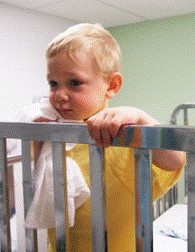Imagine yourself standing on the beach. It’s the first time you’re about to scuba dive. Your instructor is standing behind you. You’ve been going through all the security routines and potential hazards for the nth time. You’re feeling safe and comfortable. But now, something is happening. A frown on his forehead, a strange feeling in your arm, an unexpected sound from the oxygen tube. You get dead scared and begin to regret the entire project. Your thoughts keep spinning. What will happen down there, under the calm surface? No sharks down there? What if you swim into an underwater cave and don’t get out again? Finally, you hear yourself yelling: “I DON’T WANT TO! No scuba diving!” And the instructor responds, with all the clam and assurance he can muster: “Well now, everything’s gonna be just fine”.
Now, transfer this story into your being the instructor and your baby is the novice diver. I think many babies who do not want to fall asleep feel something like this: They are about to abandon a safe and recognizable world and enter an unknown, deep, and dangerous territory. “What will happen when Mum has left my room? Something strange, weird, alien?” The baby cannot put words to these fears, but we can compare them to the novice scuba diver and his/her fears and fantasies. As adults, we know it’s safe to fall asleep. We even assure the little one that it’s healthy! But since falling asleep is inevitably linked to separation and loneliness, the baby can experience the bedtime situation quite differently: “Falling asleep is to break up or even to break apart. I may have horrid dream images that will make me wake up again. Perhaps it’s better to stay awake for ever…”
In 1970, the psychoanalyst Marjorie McDonald wrote a paper called “Transitional Tunes and Musical Development” (Psychoanalytic Study of the Child, 25:503-520). She noted that the word “lullabye”, that is, the tunes we sing to our kids when tucking them to sleep, has the same root as the word for separation; “goodbye”. Her observation put me on the track to linking falling asleep with the fear of separation.

A baby who does not want to fall asleep is similar to our scuba diver. He screams and pleads to the parent not to abandon him. Yet, if we analyze such a situation more closely, we might discover that Mum or Dad is not always a very reassuring “scuba instructor”. Perhaps, the parent himself/herself does not like being abandoned. This can have an impact on the baby. After all, there is a difference if the baby intuits that the parent feels safe in assuring that falling asleep is nice and safe – or if s/he gets nervous: “Maybe we’d better do this another time. Come to my bed and you’ll go to sleep quickly.”
When a parent tells me such a story, s/he may assure me of having done everything possible – “but the boy just refuses to go to sleep!” But I notice that the parent is ambivalent about taking leave of the baby. When he starts crying, a “ghost in the nursery” perhaps awakens inside the parent. A vague and painful memory of being abandoned might surface. Or, alternatively, the parent reacts with “I certainly want him to fall asleep. But for God’s sake, I’m not gonna be harsh and unyielding as my own Dad once was. OK, I give in, but only for today, right?”
What happens when a baby, who is afraid of being abandoned, is to be tucked to sleep by a parent who is also worried and anxious? I guess that he or she will not fall asleep until the parent has grasped some underlying layers of his/her own fears. S/he also needs to channel such anxieties more optimally than via the child – which is easier said than done. Not until then will the parent be able to, by taking up a loving and decisive attitude, do what Françoise Dolto called “oral castration” (see the page Breast or bottle). This implies to speak to the baby: “It’s dark outside, Charlie. All children are asleep. It’s time for you, too, to go to sleep. We’ll meet again tomorrow morning, then I’ll be here for you.” Maybe, things will go the way you see on the right-hand picture below. Or maybe not this time, but the next time…

Various methods exist, such as the “five-minute-method”. The baby lies awake in the nursery, and every five minutes the parent enters merely to show that s/he is still there. One should be close to the child but minimize body contact, and be supportive and encouraging. The idea is to show the child that falling asleep is not dangerous and the child has not been abandoned. I hear many parents criticizing this method, because they feel it is harsh and automatic and when instituting it with their child causes them great pain. Certainly, if they read it like a cook-book recipe, that might be the consequence.
To me, it is more important to try to imagine what goes on in the child’s mind, and to explain to the child: that it’s night time, one can feel scared or lonely, but there’s a tomorrow as well, and then one will meet Mum and Dad again. The idea is not completetley different from the five-minute-method, except for one essential ingredient: talking to the child about his/her emotions. Certainly, it must be applied lovingly to be “symboligenic”, as Dolto called it. That is, the adult’s words convey to the baby – though he of course does not understand them literally – that the parents are thinking about him, trying to understand him, and thence the child can create some internal images like “Mum’s good” or “Dad’s safe”. The prerequisite is that the parent is not in the throes of his/her own separation panic. Actually, this condition needs to be fulfilled no matter which “method” you choose when tucking your child to sleep. One has to rely on one’s intuition about what the child might experience right now – and also on one’s introspection. One might pose oneself a question: “Why has falling asleep become such an issue for Charlie – and for us?” The little boy on the picture found his own method of dealing with the night-time monsters: armed with some weapon-like objects he is fast asleep. Good night, Charlie. Tomorrow is another day.
